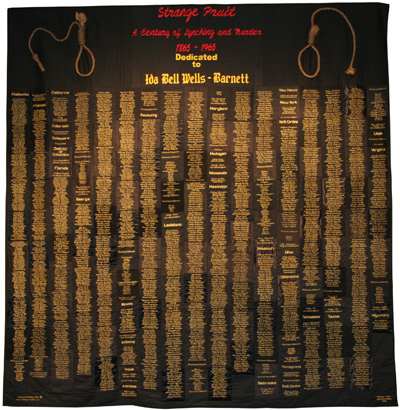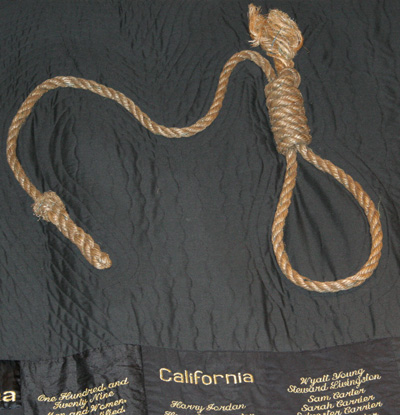
QUILT INDEX RECORD
12-8-5011
Who documented this quilt?
Michigan Quilt Project
Where are the records for this quilt housed?
Michigan State University Museum
Michigan Quilt Project Number:
08.0001
Object label:
Strange Fruit: A Century of Lynching from 1865-1965
April Shipp
Auburn Hills, Michigan
2003
Silk, cotton, denim
Machine embroidery
126” x 120”
Collection of the artist
Essay:
“Strange Fruit is named after a song by the late Billie Holiday, and it’s dedicated to Ida Bell Wells-Barnett, an African American Newspaper journalist born in 1862, who fought for an anti-lynching law. The story of my Quilt began with an episode of the Oprah show. Her guest had written a book entitled The Face of Our Past, a book dedicated to African American Women. The book was filled with marvelous photos, but one picture was not so marvelous. It was a post card of a mother and her son who had been lynched side by side from a bridge. Until that moment, it never occurred to me that they lynched women, also. Photos were often taken of people who had been lynched. These pictures were called post cards because that was what they were. I have a son who at the time was only five. I thought, if an angry mob came after my boy what would I do? Who do you turn to for help when the whole town is coming after your child? I began to pray, "Father God, someone needs to do something about this." These people need to be known, if not their stories, at least their names. I believe the spirit of the Lord spoke to me, "Find their names and make a quilt."
“Strange Fruit weighs 12 pounds and its 10' long by 10'6" wide. The fabrics are various shades of black. In making this Quilt, I learned that it didn’t matter who you were. It didn’t matter how old you were. It could happen to anyone, anywhere, and anytime. I did this Quilt in loving memory of my people, people I have never met, people whose names are not only woven into the fabric of this Quilt, but also into the fabric of my heart.”
Quilt's title:
Strange Fruit: A Century of Lynching
Subject of the quilt:
Civil rights
When was the form filled out?
2/7/2008
Quilt top made by:
Shipp, April
Quilted by:
Shipp, April
If you are the quilt owner, how did you acquire this quilt?
Made the quilt
Where the quilt was made, city:
Auburn Hills
Where the quilt was made, county:
Oakland
Where the quilt was made, state:
Michigan (MI)
Where the quilt was made, country:
United States
Time period:
2000-2025
When was the quilt finished?
2003
Why was the quilt made?
Art or personal expression; Commemorative
Quilt is presently used as:
Artwork/wall hanging
Quiltmaker's gender:
Female
Quiltmaker's city:
Auburn Hills
Quiltmaker's county:
Oakland
Quiltmaker's state:
Michigan (MI)
Quiltmaker's country:
United States
In which kind of environment did the quiltmaker live?
Urban
This is a:
Finished quilt
How wide is the quilt?
120"
How long is the quilt?
126"
Shape of edge:
Straight
Shape of corners:
Straight
What color is the quilt?
Black; Gold; Red
Quilt's condition:
Excellent/like new
Type of inscription:
Multiple Names
What is inscribed on the quilt?
Strange Fruit. A Century of Lynching and Murder 1865-1965 (in red machine embroidery) Dedicated to Ida Bell Wells-Barnett (in gold machine embroidery) 100s of names of victims of lynchings and their states (in gold machine embroidery)
What is the date inscribed on the quilt?
1865-1965
Method used to make the inscription:
Embroidery
Location of inscription:
on block
Describe the quilt's layout:
Block pattern
Number of quilt blocks:
170 blocks contain names. 13 blocks for the title and dedication, 2 large blocks for the nooses
Size of quilt blocks:
6 1/2" x 8" for the names
Arrangement of quilt blocks:
Straight
Spacing of quilt blocks:
Side by side
What is the shape of the quilt blocks?
Same block throughout
Fiber types used to make the quilt top:
Cotton; Silk
Fabric types used to make the quilt top:
Other
Describe the fibers or fabrics in the quilt top:
Corduroy
Piecing techniques used to make the quilt top:
Machine Piecing
Can you feel or see paper on the quilt that was used as a construction aid?
no
Embellishment techniques used to make the quilt top:
Embroidery
Embellishments used:
Cotton thread
Describe embellishment materials or techniques:
Metallic thread
Materials used to make the back:
Cotton
Materials used in the quilt binding:
Cotton
How is the binding made?
Straight grain; Front turned to back
What is the width of the binding (measure on the top only)?
half inch - one inch
What kind of filling is used in the quilt?
Cannot tell
How thick is the quilt?
Medium (3/16?)
How are the layers held together?
Machine quilting
Can you see any knots on the front or back of the quilt?
no
Quilting designs used, overall motifs:
In-the-ditch
Features or notes about the quilt's appearance, materials, or construction:
Strange Fruit is named after a song by the late Billie Holiday, and it’s dedicated to Ida Bell Wells-Barnett, an African American Newspaper journalist born in 1862, who fought for an anti-lynching law. The story of my Quilt began with an episode of the Oprah. Her guest had written a book entitled The Face of Our Past, a book dedicated to African American Women. The book was filled with marvelous photos, but one picture was not so marvelous. It was a post card of a mother and her son who had been lynched side by side from a bridge. Until that moment, it never occurred to me that they lynched women, also. Photos were often taken of people who had been lynched. These pictures were called post cards because that was what they were. I have a son who at the time was only five. I thought, if an angry mob came after my boy what would I do? Who do you turn to for help when the whole town is coming after your child? I began to pray, "Father God, someone needs to do something about this." These people need to be known, if not their stories, at least their names. I believe the spirit of the Lord spoke to me, "Find their names and make a quilt." Strange Fruit weighs 12 pounds and its 10' long by 10'6" wide. The fabrics are various shades of black. In making this Quilt, I learned that it didn’t matter who you were. It didn’t matter how old you were. It could happen to anyone, anywhere, and anytime. I did this Quilt in loving memory of my people, people I have never met, people whose names are not only woven into the fabric of this Quilt, but also into the fabric of my heart. Thank you in advance for reading my Letter. The name of my Quilt is Strange Fruit, it is named after a song by the late Billie Holiday, and it is dedicated to Ida Bell Wells-Barnett, an African American Newspaper jounalist and author born in 1862, who fought so tirelessly for an anti-lynching law. I, myself, am not a singer or reporter, I am a Quilter. The story of my Quilt began with an episode of the Oprah show that I missed. Her guest had written a book entitled The Face of Our Past, a book dedicated to African American Women. I had no real interest in the book, nor had I planned to buy it. A co-worker, would ask me everday if I had seen the book, so to satisfy Chris, I went to the bookstore. The book was filled with marvelous photos, but one picture was not so marvelous. It was a post card of a mother and her son who had been lynched side by side from a bridge over the water. Until that moment, it never occurred to me that they lynched women, also. Since then, I discovered that photos were often taken of people who had been lynched. These pictures were called post cards because that was what they were. Just add a stamp, your ocmments to the back, and put in the U.S. mail. I put the book down and walked to my car. I have a son who at the time was only five. I thought, if an angry mob came after my boy what would I do? Who do you turn to for help when the whole town is coming after your child? For a brief moment in time, I was there with that mother. I heard her cry, "Please, don't take my boy! Please, don't kill my son!" I saw her cry, felt her pain. My heart began to ache. What crime had she committed, loving her son too much? Once in the safety of my car with tears in my eyes, I began to pray, "Father God, someone needs to do something about this." These people need to be known, if not their stories, at least their names. These were poeple, my people! I believe the spirit of the Lord spoke to me, "Find their names and make a quilt," "Father, I can't," was my reply. I began telling GOD all the reason why I could not do the Quilt: It would be too big; I'm not qualified; it would be too hard; and my all-time favorite, Lord, you don't really want to use me, pick someone else. Needless to say, He won, and I began to make the quilt. That was five years ago. Strange fruit weighs 12 pounds, and it is 10' long by 10'6" wide. I used my Husqvarna Designer 1 to embroider the names. The fabrics are various shades of black to symbolize the color of my people. Because I believe that everyone is precious in the eyes of God, I used Sulky Gold no.7007 thread to embroider the names. The textures represent their position in life, i.e. silk, cotton, and denim. In making this Quilt, I learned that it did not matter who you were. Just ask Detective Albert Parker (lynched 1868) or Reverend L.C. Baldwin (murdered 1956). It did not matter how old you were. Just ask Virgil Ware, age 13 (murdered 1963) or the 3 murdered children of Thomas Harris. It could happen to anyone, anywhere, and anytime. I did this Quilt in loving memory of my people, people I have never met, people whose names are not only woven into the fabric of this Quilt, but also into the fabric of my heart. This Quilt is truly a miracle!
Where did the maker find their pattern?
Original to maker
Exhibitions where this quilt was displayed:
Quilts and Human Rights, Michigan State University Museum, January 15 - August 24, 2008
Person filling out this form is:
Quiltmaker
Ownership of this quilt is:
Private
Quilt owner's name:
April Shipp
Quilt owner's city:
Auburn Hills
Quilt owner's county:
Oakland
Quilt owner's state:
Michigan (MI)
Quilt owner's country:
United States
How was this quilt acquired?
Made by owner
Details
Access and copyright information:
Restricted
How did the quiltmaker participate in the creation of the quilt?
Made entire quilt
The quilt was made to be used for:
Artwork/wall hanging
Who photographed this quilt?
Pearl Yee Wong
Copyright holder:
Michigan State University Museum
Cite this Quilt
Shipp, Apri. Strange Fruit: A Century of Lynching. 2003. From Michigan State University Museum, Michigan Quilt Project. Published in The Quilt Index, https://quiltindex.org/view/?type=fullrec&kid=12-8-5011. Accessed: 04/24/24
-
Lesson Plan
In Honor of Quilting
Davis, Jaffe
-
Gallery
Themes for Educators: African American...
Sikarskie, Amanda Grace
-
Exhibit
Quilts and Human Rights
MacDowell, Marsha; Worrall, Mary; Swanson, Lynne
-
Lesson Plan
Social Justice Quilt
Gargano, Joel
-
Shipp, April Anue Quiltmaker
Black Diaspora Quilt History Project; Women of Color Quilters Network
